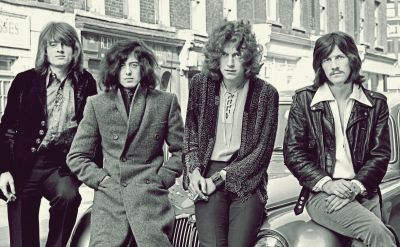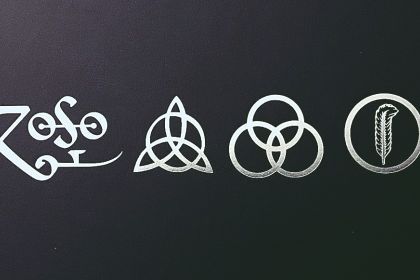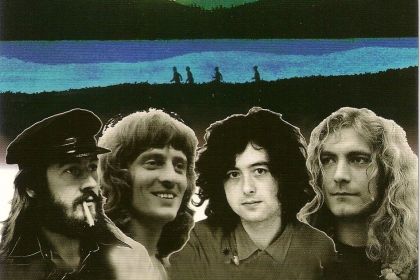Music Theory
Mixolydian mode in Led Zeppelin songs

Led Zeppelin BBC Sessions LP cover
It's no secret that Western music theory offers three major diatonic modes—Ionian, Lydian, and Mixolydian—each serving as crucial tools for songwriters seeking to craft compositions with a major mood. Among these modes, Ionian reigns supreme in both classical and pop music thanks to its universally harmonious structure. The other two major modes occupy a more modal status. Leveraging these modal diatonic modes to construct chord progressions that harmonize vocal lines opens up an additional array of emotional nuances within songs, making them readily recognizable to listeners.
Upon scrutinizing the harmonic structures of songs by leading rock bands, we've discerned a notable preference for the Mixolydian mode over the Lydian mode. Consider these statistics:
- The Beatles - 14 Mixolydian / 2 Lydian
- Led Zeppelin - 10 Mixolydian / 2 Lydian
- The Doors - 4 Mixolydian / 1 Lydian
- Pink Floyd - 2 Mixolydian / 1 Lydian
A distinguishing characteristic of the Mixolydian mode is the VII major subtonic chord, rooted in the seventh scale degree. This unique feature allows for the creation of dynamic riffs through a simple alternation of tonic and subtonic major chords, specifically the I–VII–I progression.
A limitation of this mode is the minor quality of the v dominant chord rooted in the fifth scale degree, resulting in a somewhat languid sound for the v-I authentic cadence. This drawback often steers composers toward the IV–I plagal cadence, featuring the IV major subdominant chord rooted in the fourth scale degree. The chord structure of the mode is discussed in more detail in the article on 7 songs featuring Mixolydian mode.
Examining Led Zeppelin's repertoire, we notice a systematic use of Mixolydian harmony. Remarkably, 8 out of 10 of their Mixolydian songs predominantly employ just three major chords: I, IV, and VII. This pattern holds true for various key signatures with five songs in E Mixolydian, two songs in A Mixolydian, and one song in D Mixolydian. Such a choice of keys aligns perfectly with the group's guitar-centric approach as these keys offer optimal convenience for guitarists.
One exemplary instance is How Many More Times, a composition entirely grounded in Mixolydian. In the harmonic analysis of the song chord chains, the scale degrees (denoted with Roman numerals) show the following progression in E Mixolydian appearing through song sections: E7–D–E7 or I7–VII–I7. This signature riff occasionally incorporates the A or A7 subdominant chords, thus encompassing all three major Mixolydian chords within the track.
Listen to How Many More Times (Remaster) by Led Zeppelin:
Similarly, Whole Lotta Love predominantly features Mixolydian progressions frequently accompanied by the recurring two-chord riff E7–D–E7 or I7–VII–I7. The A subdominant chord makes a brief appearance at 4:18.
Listen to Whole Lotta Love (Remaster) by Led Zeppelin:
In Hots On For Nowhere—another track in E Mixolydian—the composition relies on just three major chords: E, D, and A.
Listen to Hots On For Nowhere (Reference Mix) Led Zeppelin:
Communication Breakdown is written in E Mixolydian but occasionally deviates into E Ionian. Except for the choruses, all sections of the song follow the progression: E–D–A–D or I–VII–IV–VII. The choruses feature a classical Ionian-mode half cadence evident from the presence of the B7 major dominant chord (marked in red): A7–B7 or IV7–V7.
Listen to Communication Breakdown (Remaster) by Led Zeppelin:
In the Evening is another composition blending the E Mixolydian and the E Ionian modes. Its verses predominantly feature the characteristic Mixolydian progression: E–D–A or I–VII–IV. Meanwhile, the chorus follows this chord sequence: D–A–D or VII-IV–VII. Notably, the tonic chord is deliberately avoided, generating harmonic tension that finds resolution with the emergence of the tonic chord at the outset of the next verse.
Some choruses, particularly the first at 2:33, exhibit more intricate harmony: G–D–G–E–A–E–A–B. This section introduces a tonal shift to D Mixolydian/Ionian (G–D–G), culminating in a potent half cadence in E Ionian: E–A–E–A–B or I–VI–I–IV–V.
Listen to In the Evening (Remaster) by Led Zeppelin:
Gallows Pole showcases progressions that encompass all three major chords in A Mixolydian: A, G, and D.
Listen to Gallows Pole (Remaster) by Led Zeppelin:
Living Loving Maid (She's Just a Woman) is a composition that combines the A Mixolydian and the A Ionian modes. The piece predominantly follows the same three-Mixolydian-major-chord pattern: A–G–A–G–A–D–A or I–VII–I–VII–I–IV–I. In the bridges, we encounter the Ionian classical half cadence marked by the progression D–A–D–E or IV–I–IV–V. This progression perfectly complements the lyrics:
Come on babe on the roundabout, ride on the merry-go-round
We all know what your name is, so you better lay your money down
Listen to Living Loving Maid (She's Just a Woman) (Remaster) by Led Zeppelin:
Thank You is a clever fusion of Mixolydian and Lydian modes, as discussed in detail in our article Lydian mode in Led Zeppelin songs.
Finally, let's explore two songs that introduce minor chords, adding subtle complexity to Led Zeppelin's characteristic three-major-chord Mixolydian progressions.
In The Rover, the song narrative predominantly revolves around an intricate riff built on variations of the E tonic chords and the A subdominant chords. This riff can be attributed to both E Ionian and E Mixolydian modes.
The Mixolydian mode reveals itself in the progressions:
- F♯m–E–D–F♯m–A–E or ii–I–VII–ii–IV–I
- F♯m–E–D–C♯m–Bm or ii–I–VII–vi–v
Note the tricky descending line from the ii to v in the second progression.
Listen to The Rover (1993 Remaster) by Led Zeppelin:
South Bound Suarez, composed in C Mixolydian, sees its verses' progression straddling both Ionian and Mixolydian modes: C–Am–C–Am or I–vi–I–vi.
The chorus chord chains are as follows:
- F–C–F–C–F–C or IV–I–IV–I–IV–I
- B♭–F–C or VII–IV–I
These sequences exemplify the typical Led Zeppelin Mixolydian pattern of three major chords.
Listen to South Bound Saurez (Remaster) by Led Zeppelin:
To delve further into Led Zeppelin's use of various musical modes, you can explore our articles on:
- Dorian mode in Led Zeppelin songs
- Aeolian mode in Led Zeppelin songs
- Lydian mode in Led Zeppelin songs
- No Quarter: two minor modal modes of Led Zeppelin's psychedelic track
- Boogie with Stu: origins of Led Zeppelin's song featuring mandolin solo
- D'yer Mak'er: meaning of Led Zeppelin's most controversial song
You can also discover more songs composed in the Mixolydian major mode and explore their harmonic analysis in the following articles:
- 7 songs featuring Mixolydian mode
- Mixolydian mode in The Doors songs
- Mixolydian mode in Pink Floyd songs
- Scarlet Begonias: three major Mixolydian chords in a Grateful Dead's ballad
- Carpet Crawlers: two major modes of Genesis' last studio recording
- The Bells of Rhymney: two major modal modes of famous protest song
- Seven Seas of Rhye: song of imaginary land brought to life by Ionian and Mixolydian modes
- Longfellow Serenade and the fireside poet that kindled Neil Diamond's song



